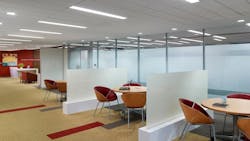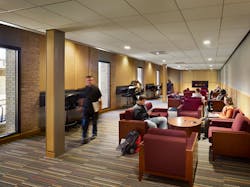Furniture itself does not inherently create a 21st-century learning environment, but the planning, combination of furniture items and their subsequent use can work to support such an environment.
Last fall, a forum was conducted with educational representatives of the U.S. Department of Defense Education Activity committee, whose pre-K to 12 schools serve the children of military service and defense department employees throughout the world. The discussions began with a general overview of planning strategies, which were integral to identifying the characteristics of each furniture item that would be deemed most beneficial.
Called the “Basis of Design,” the guidelines are intended to be used as a tool in the development of FFE packages. The “Basis of Design” also parallels changing trends in the workplace to support:
•Differentiated learning.
•Collaborative/project-based environments.
•Technology as a teaching tool.
•Multi-function, reconfigurable and storable furniture.
Furniture choices
Education institutions can adhere to general guidelines based on the concepts and practices inherent in 21st-century learning environments:
•Flexibility and Adaptability:
-Furniture should be flexible to enable immediate changes to the learning environment. With lightweight, reconfigurable and storable furniture, differentiated learning spaces have less need for storing “function-specific” furniture.
-Furniture should be adaptable for possible future changes to the learning environment that may require tools. For instance: height-adjustable tables that can be adjusted by the maintenance staff not only for the majority of users, but also for special-needs students.
-Furniture should include options that will create inclusion for special-needs students and instructors. Adjustable-height tables at a suitable width can be adapted to accommodate a wheelchair. The addition of arms to an otherwise armless chair will ease transition and seating for certain students. Providing mobile screens with acoustic properties can help reduce distractions.
Functionality:
-Appropriateness and durability of furniture components for grade level and curriculum will take precedence over other factors. For instance, a high school science lab requires worktables with surfaces that can resist harsh chemicals, be stable enough and at an appropriate work height to prevent spills. These same tables may not be appropriate for a computer/graphics lab that will want to be reconfigurable and provide options for wire management.
-Furniture should support technology as a separate component so that technology upgrades may occur at a faster rate than replacement of furniture. Separating furniture and technology also promotes the sharing of equipment.
-Personal student storage often is warranted and will give students a sense of belonging and ownership. Personal items that may require storage include lunches, items for after-school activities, coats, umbrellas and notebooks. The goal is to reduce the number of items students need to carry throughout the day by situating lockers closer to their “home base.”
-Storage lockers traditionally are included in the construction package as built-ins. For those instances when they are not built-in, lockers shall be included in the FFE package and will in turn provide a greater degree of adaptability. They should remain in a single location using mostly low-height, reduced-sized compartmentalized lockers.
It is not recommended that personal student storage be incorporated into seating or desks because backpacks do not fit in these compartments, and often eliminate the ability to stack chairs and reduce leg room. For open cubbies at the pre-K/kindergarten level, it is best to keep students’ personal clothing separated for hygiene reasons. Using the same footprint, a divided double cubby is ideal.
-Personal student storage needs vary by grade level and region and may need to be supplemented in studios and labs with such features as coat hooks or open cubbies for readily available books, supplies and backpacks.
-Dual-purposed furniture should be incorporated to maximize space utilization. Providing low storage cabinets that can function as room dividers, storage and additional worksurfaces are a few of the ways that schools can more efficiently use space while maintaining flexibility.
•Ergonomics:
-Providing furniture with ergonomic qualities to suit a majority of users establishes a foundation for improved productivity and longer attention spans.
-Seating shall have “flex,” full back support, adjustable height or age-appropriate height, waterfall edge seat and accommodate varied seating positions.
-Opportunities for stool-height tables enable students to stand during project-based or instructional learning.
•Relationship of architectural space and furniture components:
-Just as appropriate lighting, air quality and the architectural design of a space contribute to a successful learning environment, so too do the furniture components used in a space. The architectural environment for 21st-century learning is intended to be as dynamic as the learning experience.
Neighborhood studios should be established with some walls having movable partitions that open to each other or to the central hub, instead of having traditional static classrooms constructed of block walls. The furniture in these spaces needs to easily adjust to varied spatial configurations.
-In some instances, components that have been traditional elements in the construction package will be moved into the FF&E package to support the concepts of 21st-century directives. The FF&E package should accommodate this by including alternatives that can be categorized as furniture to substitute for lockers, library stacks and general millwork.
•Aesthetics:
-Color, form and texture foster creativity and a sense of identity in students. These features should be chosen to endure the test of time and be based on the principal foundations of design and not the latest trends.
-Generally, younger children prefer warm, bright colors based on association with positive feelings; high-energy, older students prefer cooler and more neutral colors. Some furniture should be available in accent color choices appropriate for the age level, in addition to neutral material finishes to suit a multitude of users.
-Contemporary styling will provide “branding” to inform the community that the schools are moving toward 21st-century learning environments. Even if furniture is introduced slowly in transitioning spaces for an existing school, it is acceptable to mix existing with new contemporary pieces in the same environment.
-Metal finishes shall be available in silver as a minimum provision. This will coordinate best with most architectural finishes, as well as all other furniture finish options.
-Opportunities to showcase student achievements should be provided by using cases and mobile display walls.
Bingham is an interior designer for EwingCole, Philadelphia. (215)625-4179

